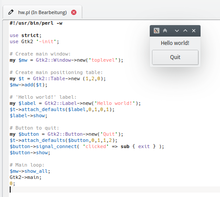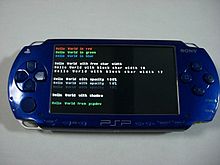"Hello, World!" program: Difference between revisions
Nucleusboy (talk | contribs) m Reverted 1 edit by 98.77.209.54 identified as vandalism to last revision by Andy Dingley. (TW) |
|||
| Line 10: | Line 10: | ||
==Purpose== |
==Purpose== |
||
A "hello world" program has become the traditional first program that many people learn. In general, it is simple enough that people who have no previous experience with computer programming can easily understand it, especially with the guidance of a teacher or a written guide. Using this simple program as a basis, [[computer science]] principles or elements of a specific [[programming language]] can be explained to novice programmers. Experienced programmers learning new languages can also gain a lot of information about a given language's syntax and structure from a hello world program. |
|||
nigga! |
|||
In addition, hello world can be a useful [[sanity test]] to make sure that a language's [[compiler]], [[development environment]], and [[run-time environment]] are correctly installed. Configuring a complete programming [[toolchain]] from scratch to the point where even trivial programs can be compiled and run can involve substantial amounts of work. For this reason, a simple program is used first when testing a new tool chain. |
|||
"Hello world" is also used by computer hackers as a [[proof of concept]] that arbitrary code can be executed through an [[Exploit (computer security)|exploit]] where code ''should not'' be allowed to be executed, for example, on Sony's [[PlayStation Portable]]. This is the first step into making home-made content ("[[Homebrew (video games)|homebrew]]") usable on such a device. |
|||
==History== |
==History== |
||
Revision as of 19:26, 26 July 2010



A "Hello World" program is a computer program which prints out "Hello World!" on a display device. It is used in many introductory tutorials for teaching a programming language. Such a program is typically one of the simplest programs possible in most computer languages. It is often considered to be tradition among programmers for people attempting to learn a new programming language to write a "Hello World!" program as one of the first steps of learning that particular language. Some are surprisingly complex, especially in some graphical user interface (GUI) contexts, but most are very simple, especially those which rely heavily on a particular command line interpreter ("shell") to perform the actual output. In an embedded system, the text may be sent to a liquid crystal display (LCD), or the message may be substituted by some other appropriate signal, such as an LED being turned on.
Purpose
A "hello world" program has become the traditional first program that many people learn. In general, it is simple enough that people who have no previous experience with computer programming can easily understand it, especially with the guidance of a teacher or a written guide. Using this simple program as a basis, computer science principles or elements of a specific programming language can be explained to novice programmers. Experienced programmers learning new languages can also gain a lot of information about a given language's syntax and structure from a hello world program.
In addition, hello world can be a useful sanity test to make sure that a language's compiler, development environment, and run-time environment are correctly installed. Configuring a complete programming toolchain from scratch to the point where even trivial programs can be compiled and run can involve substantial amounts of work. For this reason, a simple program is used first when testing a new tool chain.
"Hello world" is also used by computer hackers as a proof of concept that arbitrary code can be executed through an exploit where code should not be allowed to be executed, for example, on Sony's PlayStation Portable. This is the first step into making home-made content ("homebrew") usable on such a device.
History
While small test programs existed since the development of programmable computers, the tradition of using the phrase "Hello world!" as a test message was influenced by an example program in the seminal book The C Programming Language. The example program from that book prints "hello, world" (without capital letters or exclamation mark), and was inherited from a 1974 Bell Laboratories internal memorandum by Brian Kernighan, Programming in C: A Tutorial, which contains the first known version:
#include <stdio.h>
int main()
{
printf("hello, world");
return 0;
}
The first known instance of the usage of the words "hello" and "world" together in computer literature occurred earlier, in Kernighan's 1972 Tutorial Introduction to the Language B[1], with the following code:
main( ) {
extrn a, b, c;
putchar(a); putchar(b); putchar(c); putchar('!*n');
}
a 'hell';
b 'o, w';
c 'orld';
Variations
There are many variations on the punctuation and casing of the phrase. Variations include the presence or absence of the comma and exclamation mark, and the capitalization of the 'H', both the 'H' and the 'W', or neither. Some languages are forced to implement different forms, such as "HELLO WORLD!", on systems that only support capital letters, while many "hello world" programs in esoteric languages print out a slightly modified string. For example, the first non-trivial Malbolge program printed "HEllO WORld", this having been determined to be good enough.
There are variations in spirit, as well. Functional programming languages, like Lisp, ML and Haskell, tend to substitute a factorial program for Hello World, as the former emphasizes recursive techniques, which are a big part of functional programming, while the latter emphasizes I/O, which violates the spirit of pure functional programming by producing side effects.
The Debian and Ubuntu Linux distributions provide the "hello world" program through the apt packaging system; this allows users to simply type "apt-get install hello" for the program to be installed, along with any software dependencies. While of itself useless, it serves as a sanity check and a simple example to newcomers of how to install a package. It is significantly more useful for developers, however, as it provides an example of how to create a .deb package, either traditionally or using debhelper, and the version of hello used, GNU hello, serves as an example of how to write a GNU program.[2]
See also
- Foobar
- Just another Perl hacker
- List of basic computer science topics
- Trabb Pardo-Knuth algorithm
- At Wikibooks:
References
External links
- Programming in C: A Tutorial by Brian Kernighan — internal Bell Labs memo, containing the above C program
- The "Hello World" curve
- Hello World collection with 400+ programs, including "Hello World" in 60+ human languages
- MSDN – "Hello Data" example database
- HelloWiki.org, a wiki based Hello World collection, with helpful comments and links for starting.
- Hello World! Visual Prolog Video Tutorial demonstrates basic IDE features while creating a Visual Prolog "Hello World!" program.
